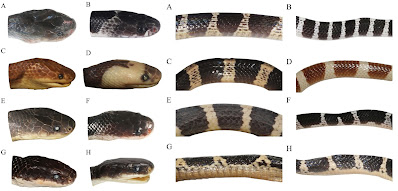 |
| Bungarus suzhenae Chen, Shi, Vogel, Ding & Shi, 2021 Suzhen’s Krait | “素贞环蛇 || DOI: 10.3897/zookeys.1025.62305 |
Abstract
Kraits of the genus Bungarus Daudin 1803 are widely known venomous snakes distributed from Iran to China and Indonesia. Here, we use a combination of mitochondrial DNA sequence data and morphological data to describe a new species from Yingjiang County, Yunnan Province, China: Bungarus suzhenae sp. nov. Phylogenetically, this species forms a monophyletic lineage sister to the Bungarus candidus/multicinctus/wanghaotingi complex based on cyt b and ND4 genes but forms a sister species pair with the species B. magnimaculatus Wall & Evans, 1901 based on COI gene fragments. Morphologically, B. suzhenae sp. nov. is similar to the B. candidus/multicinctus/wanghaotingi complex but differs from these taxa by a combination of dental morphology, squamation, coloration pattern, as well as hemipenial morphology. A detailed description of the cranial osteology of the new species is given based on micro-CT tomography images. We revised the morphological characters of B. candidus/multicinctus/wanghaotingi complex and verified the validity of three species in this complex. The distribution of these species was revised; the records of B. candidus in China should be attributed to B. wanghaotingi. We also provide an updated key to species of Bungarus.
Keywords: Bungarus suzhenae sp. nov., cranial osteology, hemipenial morphology, micro-computed tomography, phylogeny, taxonomy
 |
| Figure 10. Holotype of Bungarus suzhenae sp. nov. (CIB 116088) A dorsal view of body B ventral view of body C dorsal view of head D left lateral view of head E right lateral view of head. |
 |
| Figure 11. Paratype of Bungarus suzhenae sp. nov. in life (Adult female CIB 116090). |
Bungarus suzhenae sp. nov.
Etymology: The specific epithet of the new species was named after Su-Zhen Bai, a famous powerful goddess of Chinese myth The legend of the White snake (白蛇传), in honor of her courage to true love and kindness to people. The common name is suggested as “Suzhen’s Krait” in English and “素贞环蛇 (sù zhēn huán shé)” in Chinese. งูสามเหลี่ยมไป๋ซู่เจิน
Distribution and ecology: Bungarus suzhenae sp. nov. was found in rice fields, streams in monsoon forest at elevation from 800 m to 1,560 m. This species is distributed in Yingjiang Country, Yunnan Province, China and Kachin State, Myanmar (Fig. 1). In captivity, they prey on eels like Monopterus albus and small snakes such Xenochrophis flavipunctatus, Pareas spp., but refuse mice and frogs.
Ze-Ning Chen, Sheng-Chao Shi, Gernot Vogel, Li Ding and Jing-Song Shi. 2021. Multiple Lines of Evidence Reveal A New Species of Krait (Squamata, Elapidae, Bungarus) from Southwestern China and Northern Myanmar. ZooKeys. 1025: 35-71. DOI: 10.3897/zookeys.1025.62305




